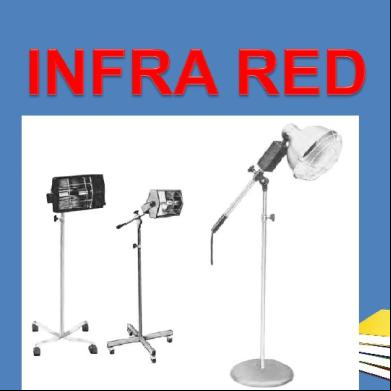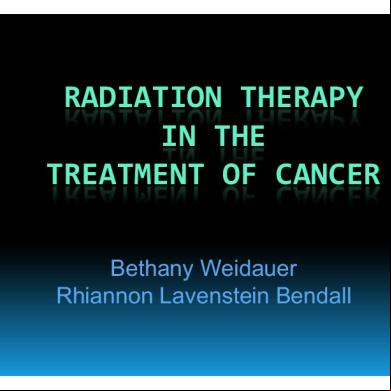Infra Red Radiation Therapy Final 1t1d1s
This document was ed by and they confirmed that they have the permission to share it. If you are author or own the copyright of this book, please report to us by using this report form. Report 3i3n4
Overview 26281t
& View Infra Red Radiation Therapy Final as PDF for free.
More details 6y5l6z
- Words: 699
- Pages: 19
INFRA RED Infrared radiations (IRR) are electromagnetic radiation that lies within that part of electromagnetic spectrum between visible light and microwave radiation. IR has no color, it is detected by warmth IR is emitted from any heated body Its wavelength is higher than visible light IR has a wavelength of 760nm to 1mm
ELECTRO MAGNETIC SPECTRUM INITIAL
WAVES
WAVELENGTH
R
RADIOWAVES
0.1 MM TO 100 KM
I
INFRA RED
750 NM TO 0.4 MM
V
VISIBLE LIGHT
400 NM TO 750 NM
U
ULTRA VIOLET
10 NM TO 400 NM
XG
X-RAY / GAMMA RAYS
0.01 PM TO 100 NM
760nm to 1 mm
CLASSIFICATION OF IR
IR IR A
IR C
760- 1400 NM
IR B
THERAPEUTIC
1400 – 3000 NM THERAPEUTIC
3000NM – 1MM NON THERAPEUTIC
Classification of infrared radiation Type
Wavelength
IRA (short or 760 - 1400 nm near IR) IRB (long or far 1400 – 3000 nm IR)
Penetration 5 mm reach to dermis Up to 1 mm to epidermis
IRC 3000nm – 1 mm Not used therapeutically
Production of Infrared • Infrared is produced as a result
of molecular motion within heated materials. All hot bodies emit IR, as increase the temperature of any material above absolute zero result in vibration and rotation of molecule within the material . • The wavelength of the emitted IR are determined by the temperature of the material. The higher the temperature of the body, the higher the frequency, and the shorter the wavelength.
Sources of Infrared • Natural sources: The sun • Artificial sources: 1- Luminous sources 2- Non-luminous sources
IR LAMPS
NON LUMINOUS GENERATOR
LUMINOUS GENERAT OR
Luminous Lamps (i.e. bulb)
• Electrically heated filament made of tungsten filament within a glass bulb which contain an inert gas at low pressure. Part of the glass bulb is silvered to provide a reflector. • Luminous sources emit mainly: - Short or near IR (IRA) - Visible light - Ultraviolet
Non-luminous (i.e. coil heater) • Non-luminous sources are those which produce infrared radiation from a non-glowing source, such as moist heat packs and non-luminous IR lamps • Non-luminous infrared lamp consists of a coiled resistance wire which embedded within a ceramic insulating material • Non - luminous sources emit mainly long or far IR radiation.
Absorption and penetration of IRR • IRR is strongly absorbed near the skin surface and the heat is carried to deeper tissues by conduction and by the circulating fluids. • The absorption and penetration of IRR rays depend on: 1- Frequency or wavelength of the rays 2- Angle of incidence of the rays. 3- The intensity of the emitting source.
Power • Smaller Lamps both luminous and non-luminous 250 to 500 W • Large Non-Luminous 750 to 1000 W • Large luminous 600 to 1500 W
Physiological Effects of Infrared
IRR is considered as superficial heating modality Cutaneous vasodilatation Erythema Increase metabolism Neurological effect Effect on connective tissue
N.B. Increasing tissue extensibility by heating through IRR will not decrease soft tissue shortening. So infrared must be used in conjunction with stretching and ROM exercises
Dosage Sensory
report of the patient Adjusted ِAdjusted by: Changing
power output of the lamp Distance of lamp Angle of incidence
Therapeutic Uses of Infrared
1. Relieve of pain 2. Reduction of muscle spasm
3. Acceleration of healing 4. Subacute and chronic
inflammation of musculoskeletal system
5. Reduction of chronic mild to
moderate edema 6. Prior to stretching & mobilizing exercises 7. Some skin conditions (fungal infection
Contraindications 1. Acute inflammation 2. Acute infection 3. Open wounds 4. Impaired sensation 5. Impaired circulation 6. Over pregnant uterus 7. Eyes 8. Metal
Proper Application • Check for any contraindications. • Clean area to be treated. • Position patient so that the lamp is perpendicular to the targeted tissue. • Intensity: adjust wattage or distance of lamp • •
Luminous = 24 inches NonLuminous = 32 inches
• Instruct patient to not move. • Check the patient often. • Instruct the patient to tell the clinician of any burning sensation.
Hazards and Dangers
• • • •
Burns Eye damage Lowered blood Pressure Areas of defective arterial blood flow • Dehydration
ELECTRO MAGNETIC SPECTRUM INITIAL
WAVES
WAVELENGTH
R
RADIOWAVES
0.1 MM TO 100 KM
I
INFRA RED
750 NM TO 0.4 MM
V
VISIBLE LIGHT
400 NM TO 750 NM
U
ULTRA VIOLET
10 NM TO 400 NM
XG
X-RAY / GAMMA RAYS
0.01 PM TO 100 NM
760nm to 1 mm
CLASSIFICATION OF IR
IR IR A
IR C
760- 1400 NM
IR B
THERAPEUTIC
1400 – 3000 NM THERAPEUTIC
3000NM – 1MM NON THERAPEUTIC
Classification of infrared radiation Type
Wavelength
IRA (short or 760 - 1400 nm near IR) IRB (long or far 1400 – 3000 nm IR)
Penetration 5 mm reach to dermis Up to 1 mm to epidermis
IRC 3000nm – 1 mm Not used therapeutically
Production of Infrared • Infrared is produced as a result
of molecular motion within heated materials. All hot bodies emit IR, as increase the temperature of any material above absolute zero result in vibration and rotation of molecule within the material . • The wavelength of the emitted IR are determined by the temperature of the material. The higher the temperature of the body, the higher the frequency, and the shorter the wavelength.
Sources of Infrared • Natural sources: The sun • Artificial sources: 1- Luminous sources 2- Non-luminous sources
IR LAMPS
NON LUMINOUS GENERATOR
LUMINOUS GENERAT OR
Luminous Lamps (i.e. bulb)
• Electrically heated filament made of tungsten filament within a glass bulb which contain an inert gas at low pressure. Part of the glass bulb is silvered to provide a reflector. • Luminous sources emit mainly: - Short or near IR (IRA) - Visible light - Ultraviolet
Non-luminous (i.e. coil heater) • Non-luminous sources are those which produce infrared radiation from a non-glowing source, such as moist heat packs and non-luminous IR lamps • Non-luminous infrared lamp consists of a coiled resistance wire which embedded within a ceramic insulating material • Non - luminous sources emit mainly long or far IR radiation.
Absorption and penetration of IRR • IRR is strongly absorbed near the skin surface and the heat is carried to deeper tissues by conduction and by the circulating fluids. • The absorption and penetration of IRR rays depend on: 1- Frequency or wavelength of the rays 2- Angle of incidence of the rays. 3- The intensity of the emitting source.
Power • Smaller Lamps both luminous and non-luminous 250 to 500 W • Large Non-Luminous 750 to 1000 W • Large luminous 600 to 1500 W
Physiological Effects of Infrared
IRR is considered as superficial heating modality Cutaneous vasodilatation Erythema Increase metabolism Neurological effect Effect on connective tissue
N.B. Increasing tissue extensibility by heating through IRR will not decrease soft tissue shortening. So infrared must be used in conjunction with stretching and ROM exercises
Dosage Sensory
report of the patient Adjusted ِAdjusted by: Changing
power output of the lamp Distance of lamp Angle of incidence
Therapeutic Uses of Infrared
1. Relieve of pain 2. Reduction of muscle spasm
3. Acceleration of healing 4. Subacute and chronic
inflammation of musculoskeletal system
5. Reduction of chronic mild to
moderate edema 6. Prior to stretching & mobilizing exercises 7. Some skin conditions (fungal infection
Contraindications 1. Acute inflammation 2. Acute infection 3. Open wounds 4. Impaired sensation 5. Impaired circulation 6. Over pregnant uterus 7. Eyes 8. Metal
Proper Application • Check for any contraindications. • Clean area to be treated. • Position patient so that the lamp is perpendicular to the targeted tissue. • Intensity: adjust wattage or distance of lamp • •
Luminous = 24 inches NonLuminous = 32 inches
• Instruct patient to not move. • Check the patient often. • Instruct the patient to tell the clinician of any burning sensation.
Hazards and Dangers
• • • •
Burns Eye damage Lowered blood Pressure Areas of defective arterial blood flow • Dehydration










